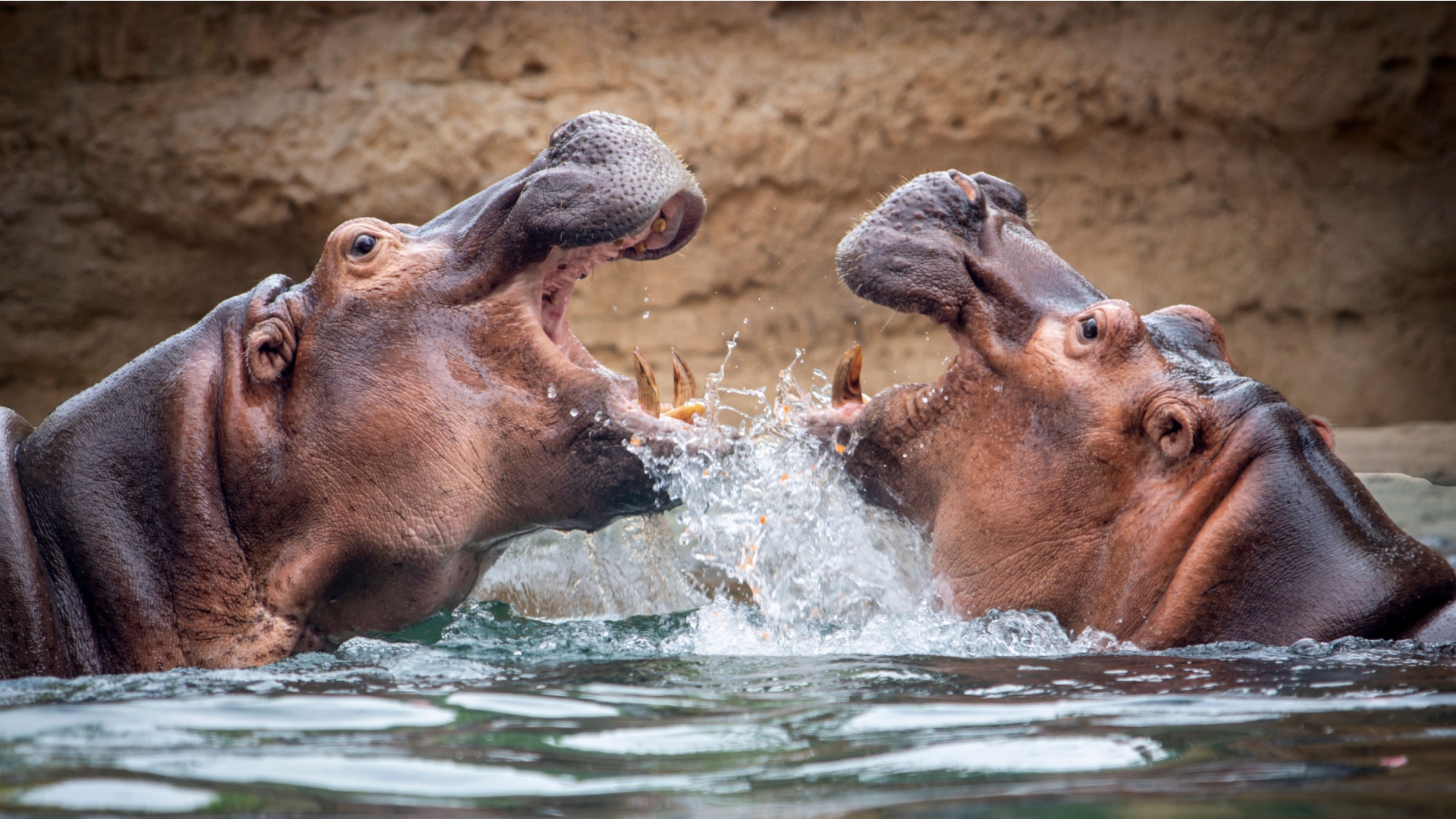The hippopotamus, a fascinating giant of the African waterways, is known for its unique characteristics and behaviors.
From its semi-aquatic lifestyle to its powerful jaws, the hippo is a creature of intrigue and wonder.
Whether you’re a wildlife enthusiast or simply curious, these facts will provide a deeper understanding of one of the Earth’s most formidable animals.
1. Hippos Love Water
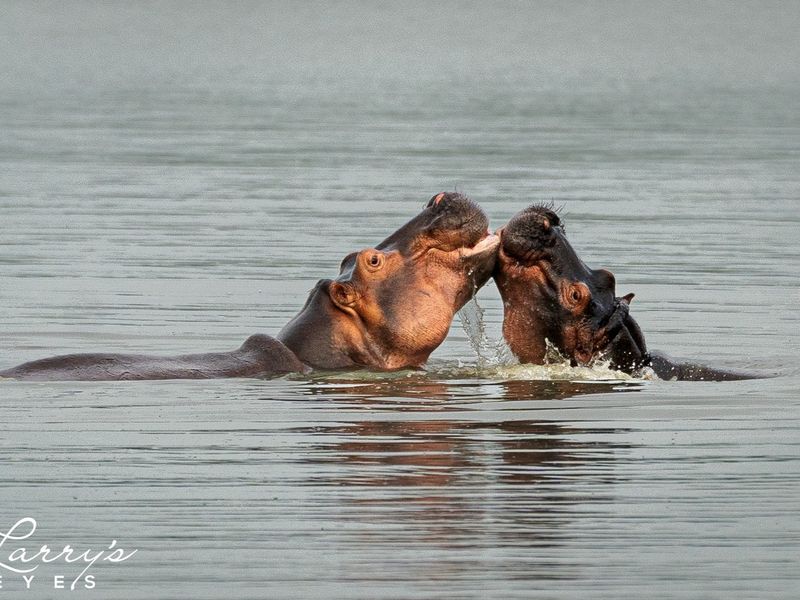
Living much of their lives in water, hippos are well-suited to aquatic environments. Their eyes, ears, and nostrils are located on top of their heads, allowing them to see, hear, and breathe while mostly submerged. This unique adaptation provides them with the ability to remain almost entirely underwater, protecting themselves from the sun’s harsh rays.
While they might look like they’re having a casual swim, they’re actually highly efficient in this habitat. Hippos can hold their breath for up to five minutes, which allows them to stay submerged for extended periods. This time underwater is crucial for them, as it helps to keep their large bodies cool in the hot African climate.
Their semi-aquatic nature is not just for comfort but essential for survival in their natural habitat. Spending most of the day in rivers and lakes, hippos come out at night to graze on grass, making the water bodies their safe haven during daylight.
2. Huge Yet Fast
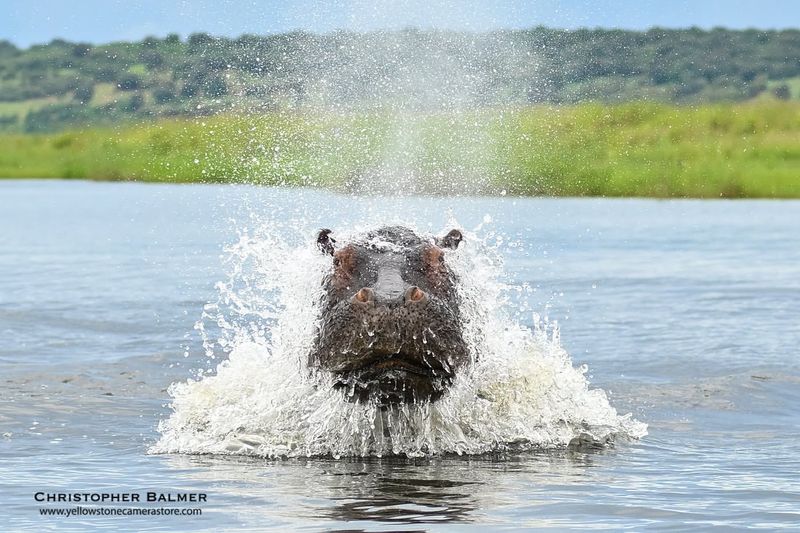
Despite their bulky appearance, hippos are capable of surprising speeds on land. These massive creatures can run at speeds of up to 19 miles per hour. This speed is particularly remarkable when considering their average weight, which can exceed 3,000 pounds. Their limbs, though short, are powerful and muscular, enabling them to move quickly over short distances.
Hippos typically use this speed as a defensive mechanism, escaping threats rather than engaging in confrontation. In the wild, their ability to move swiftly can be a crucial survival trait, helping them avoid predators and other dangers. What makes their speed even more astonishing is the contrast to their size and weight.
When you see a hippo moving swiftly, it defies the expectations set by its massive form. This speed also plays a part in their social dynamics, as they can quickly assert dominance within a group, if needed. Their surprising agility on land reflects their adaptability and resilience.
3. Hippo Social Structure
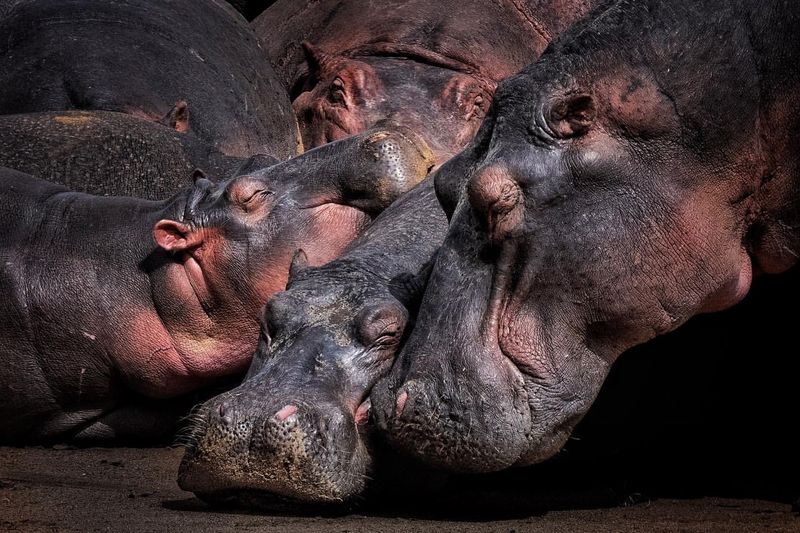
Known for their close-knit social groups, hippos often gather in pods of up to 30 individuals. These groups are dominated by a single male, who asserts his authority through size and aggression. Within these pods, social bonds are strong, especially among females and their young.
The communal living arrangement provides protection against predators and environmental threats. This social structure also facilitates breeding, as males fight to maintain control over their group and access to females. The dominant male’s role is crucial, as he must balance aggression with maintaining harmony within the pod.
Social interactions among hippos are complex, involving vocalizations, body language, and physical displays. By living in groups, hippos benefit from collective vigilance, enhancing their overall survival rates. These relationships highlight the importance of social dynamics in the wild, where cooperation and competition coexist.
Observing hippos in their natural setting reveals the intricacies of their social lives, offering insights into their behavioral ecology.
4. Remarkable Dental Weaponry
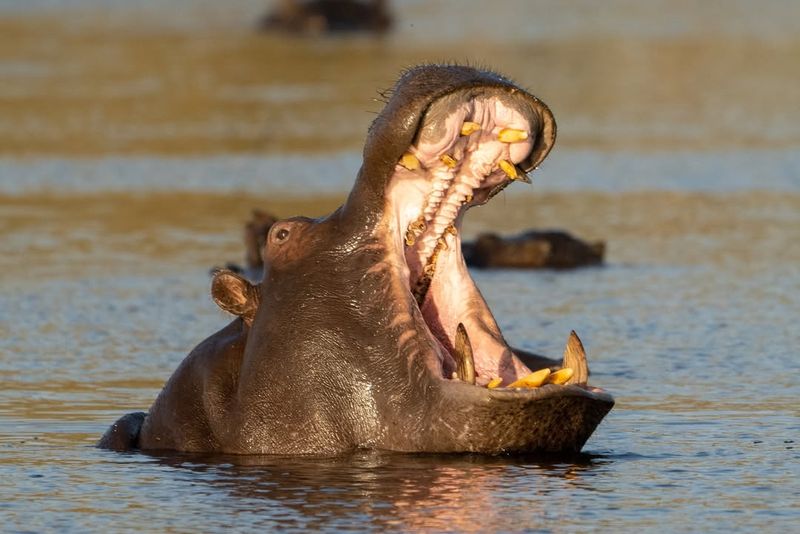
The mouth of a hippo is one of its most formidable features. Equipped with enormous jaws and tusks that can grow up to 20 inches long, they possess a powerful bite. These natural weapons are used for defense and dominance within their social groups. Interestingly, hippos’ teeth continue to grow throughout their lives, which is essential for replacing worn-down tusks and incisors.
The dental structure is not just for show; it’s a key part of their survival strategy in the wild. While they primarily feed on grass, these teeth are used to fight off threats and rivals. The size and strength of a hippo’s tusks and incisors are a testament to their role as one of nature’s most intimidating herbivores.
A hippo’s bite force is strong enough to crush a watermelon, illustrating the sheer power these animals wield. Their dental weaponry, combined with their size, makes them a force to be reckoned with.
5. Sun Protection
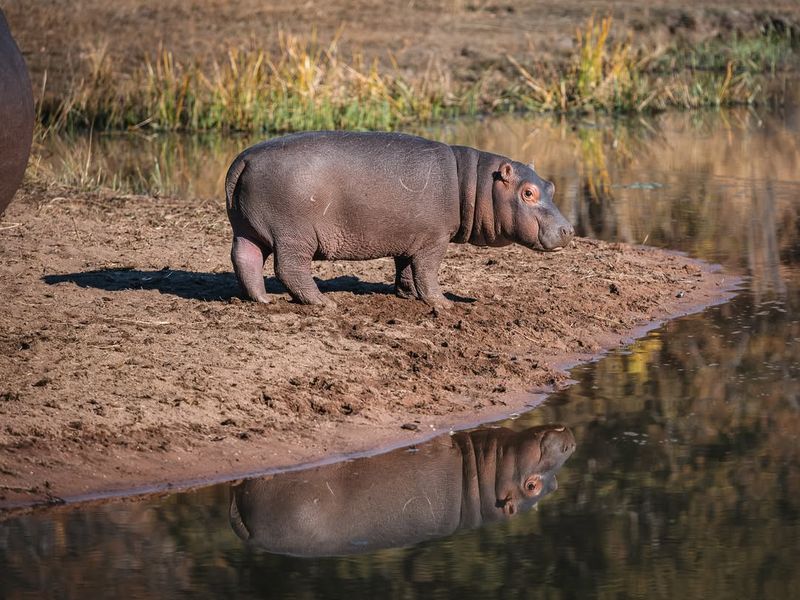
One of the lesser-known adaptations of hippos is their ability to produce a natural sunscreen. The secretion, known as “blood sweat,” appears as a reddish fluid on their skin, providing protection from the sun. This secretion is also believed to have antibacterial properties, helping to prevent infections. The red hue of the fluid can make it look like the hippo is sweating blood, a fascinating feature that has intrigued scientists and observers alike.
Their skin’s ability to secrete this substance is crucial in their sun-drenched habitats, where prolonged exposure could be harmful. This natural sunscreen is part of their unique physiological adaptations, helping them thrive in their environment. As they spend hours basking near water bodies, the protection offered by this secretion is vital.
It’s another example of how hippos are perfectly adapted to their environment, with nature providing them with the tools needed to endure the challenges they face. This feature is more than skin deep, reflecting the complexity of their biology.
6. Underwater Communication Skills
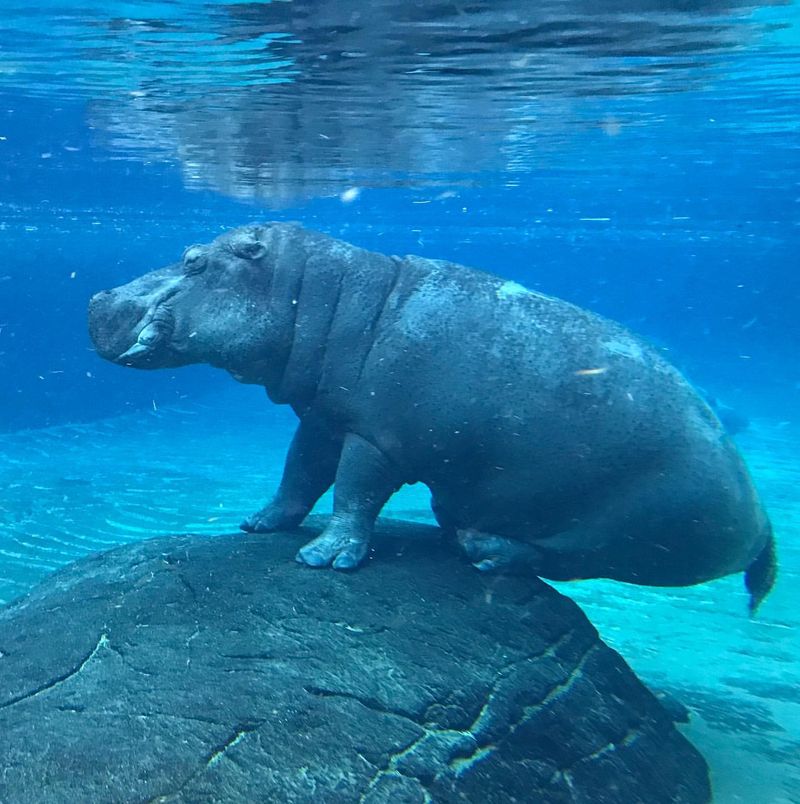
Hippos possess the remarkable ability to communicate underwater. Utilizing a combination of vocalizations and physical cues, they can send messages to one another while submerged. Their communication involves deep grunts, bellows, and wheezing sounds that travel well in water, allowing them to interact over distances.
This skill is vital in maintaining social bonds within pods and coordinating activities. The underwater acoustics play a significant role in their daily lives, from signaling danger to expressing contentment within their group. This communication is facilitated by specialized vocal cords and the structure of their heads, which enhance sound transmission.
Understanding these interactions sheds light on their social behavior, emphasizing the importance of auditory cues in their world. The ability to communicate effectively underwater is an adaptation that underscores the complexity of hippo society.
It ensures that even when visibility is low, they remain connected, highlighting the intricacies of their social dynamics.
7. Hippo Territorial Behavior
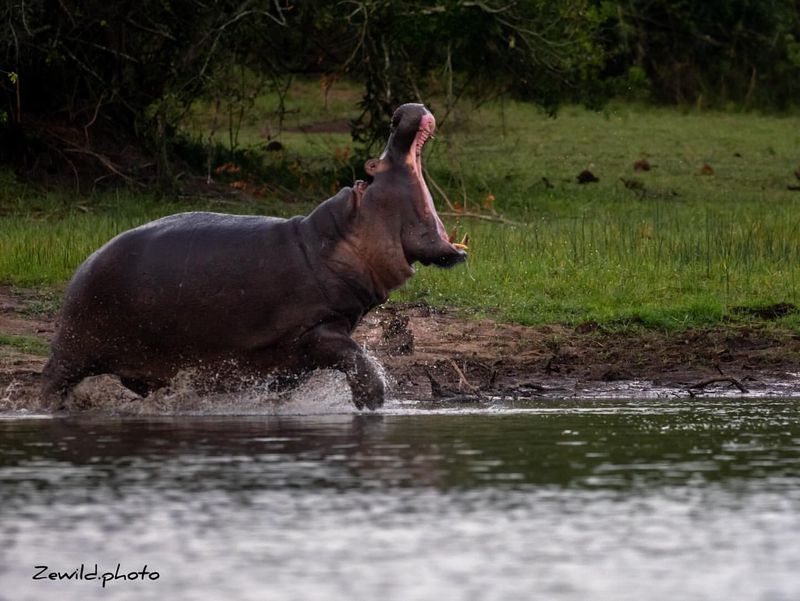
In the world of hippos, territory is of utmost importance. Males are particularly territorial, often exhibiting aggressive behaviors to defend their space. They use dung-showering, where they spin their tails while defecating, to mark their territory.
This unique behavior creates a boundary that signals to other males to keep their distance. The defense of territory is crucial for mating rights and access to resources, often leading to fierce confrontations. These territorial disputes can sometimes turn violent, with males using their powerful tusks to fight off intruders.
The importance of territory extends beyond mere space; it represents a gateway to maintaining social order and ensuring reproductive success. Females also play a role in territorial dynamics, often choosing dominant males who can protect them and their young.
Understanding hippo territorial behavior provides insights into their complex social systems and the lengths they will go to preserve their way of life. Territoriality is a defining characteristic in the lives of these remarkable animals.
8. Diet And Feeding Habits
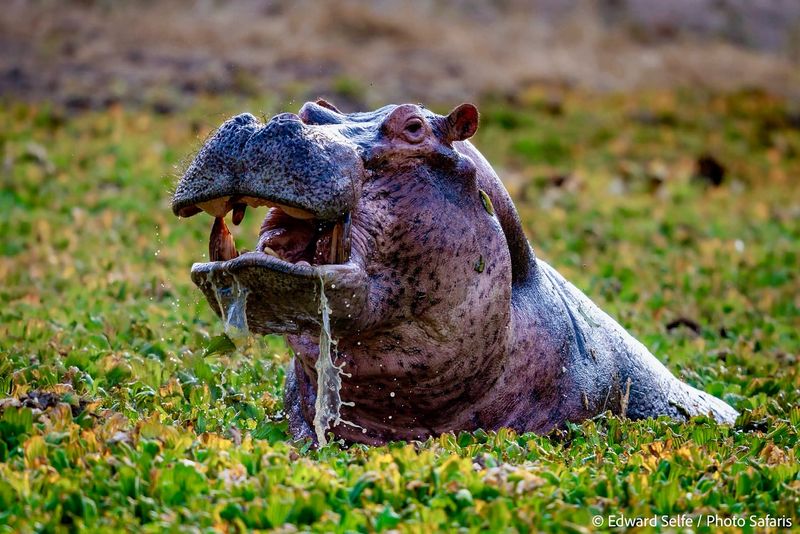
Primarily herbivorous, hippos have a diet that mainly consists of grass. Despite their large size, they consume relatively small amounts of food compared to other large herbivores, eating around 80 pounds of grass each night. Their digestive system is adapted to handle this fibrous diet, allowing them to extract necessary nutrients efficiently.
Unlike many other mammals, hippos do not ruminate, making their digestive process unique among large herbivores. This feeding behavior typically occurs at night, as they venture out of the water under the cover of darkness to graze. Their nocturnal feeding ensures they remain cool during the hottest parts of the day, conserving energy and avoiding the sun’s intense heat.
Additionally, their ability to travel several miles in search of food demonstrates their resilience and adaptability. This feeding habit highlights their role in the ecosystem as grazers, impacting vegetation patterns and contributing to the ecological balance within their habitats. Hippos’ dietary habits are a testament to their evolutionary adaptability.
9. Contribution To Ecosystems
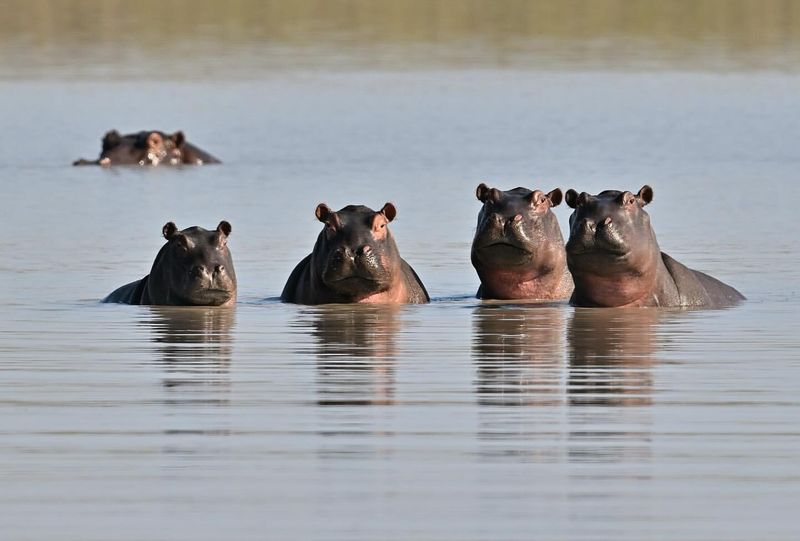
Hippos play a vital role in their ecosystems, contributing significantly to the health and balance of their habitats. By grazing on large amounts of grass, they help maintain open areas along riverbanks and prevent overgrowth of vegetation. This grazing behavior supports the growth of new plant life, which benefits other species in the area. Hippos also facilitate the redistribution of nutrients through their dung, which enriches the soil and promotes aquatic plant growth.
This nutrient cycling is essential for the overall productivity of their ecosystems, supporting a diverse range of life forms. Additionally, their presence in water bodies helps to create habitats for other species, such as fish and birds, which rely on the conditions created by hippos.
By shaping their environment, hippos contribute to the ecological balance, ensuring the survival of numerous species that depend on these habitats. Their role as ecosystem engineers underscores the interconnectedness of life in their natural habitats, highlighting the importance of biodiversity.
10. Lifespan And Longevity
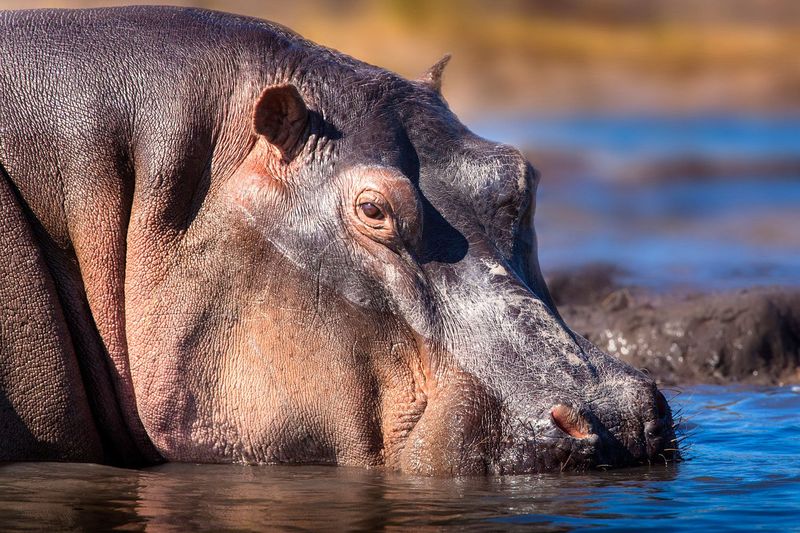
Hippos have a relatively long lifespan, living up to 40-50 years in the wild. This longevity is attributed to their robust size, which deters many potential predators, and their social structure, which provides protection. In captivity, some hippos have been known to live even longer, reaching over 60 years.
Their long life is supported by their strong social bonds, particularly the maternal care provided to young calves. Mothers are highly protective, ensuring their offspring have the best chance of survival. This nurturing behavior contributes to the species’ overall longevity, as young hippos are given the opportunity to grow and mature safely.
The extended lifespan of hippos allows them to play a consistent role in their ecosystems over many years. Their longevity also means they can experience and adapt to environmental changes, showcasing their resilience.
Understanding the factors that contribute to their lifespan provides insights into their biology and the evolutionary strategies that have allowed them to thrive.
11. Calves And Parenting
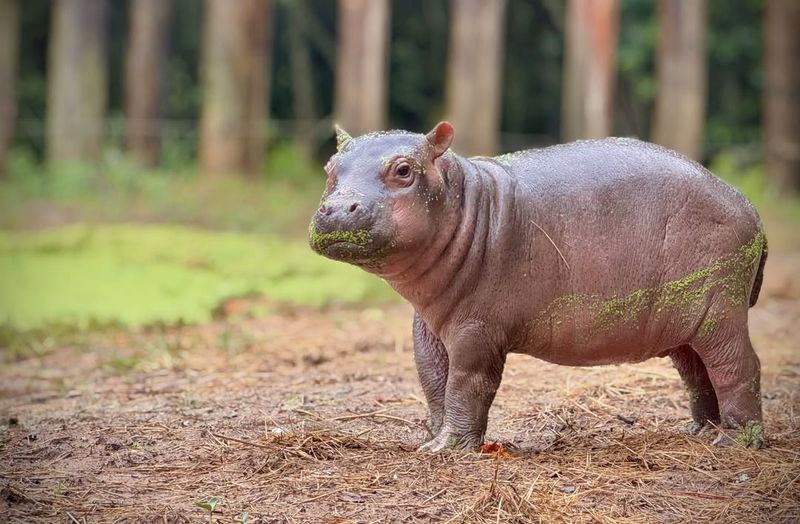
The arrival of a hippo calf is a significant event, as these young animals are born underwater. Immediately after birth, calves must make their way to the surface for their first breath. This instinctive action highlights their innate ability to thrive in aquatic environments.
Mothers are incredibly protective of their calves, often isolating themselves from the main pod to ensure safety during the early stages of life. The bond between a mother and her calf is strong, characterized by constant care and guidance. Calves rely on their mothers for nourishment, feeding on milk for the first six to eight months.
This nurturing period is crucial for their development, as they learn essential survival skills under their mother’s watchful eye. The mother-child relationship is a cornerstone of hippo social structure, with maternal instincts playing a vital role in the species’ continuation.
Observing hippo parenting behavior reveals the depth of their social interactions and the commitment to their young’s wellbeing.
12. Human Interaction
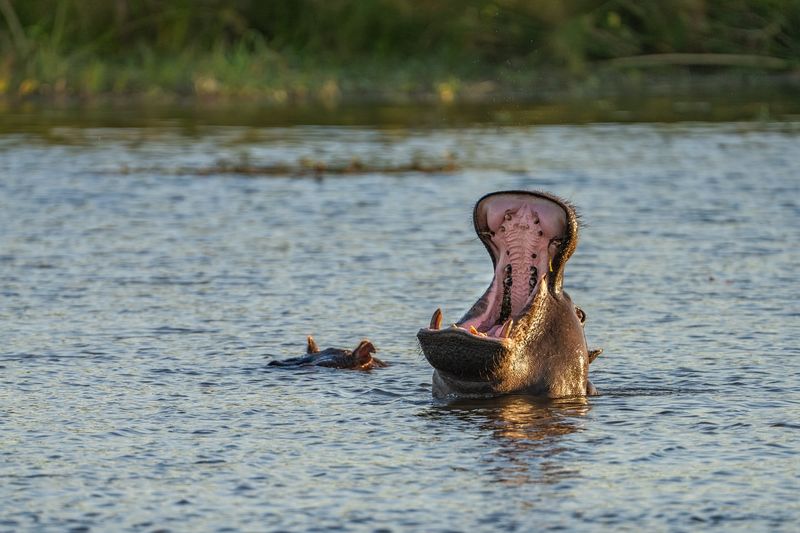
Interactions between hippos and humans can be complex, often marked by tension and misunderstanding. Despite their herbivorous nature, hippos are known to be highly aggressive towards humans when they feel threatened.
This aggression stems from their territorial instincts and the need to protect their young. Human encroachment on their habitats has led to increased conflicts, as hippos are forced to share resources with local communities. It’s crucial for people living near hippo habitats to understand their behavior and maintain a respectful distance.
Conservation efforts focus on education and creating safe zones to minimize negative interactions. By respecting hippos’ space and observing them from afar, humans can coexist with these magnificent creatures. Learning about hippos’ behavior and their role in the ecosystem fosters appreciation and helps reduce conflict.
Promoting coexistence benefits both hippos and local communities, ensuring the protection of these incredible animals and their habitats.
13. Hippos’ Unique Physiology
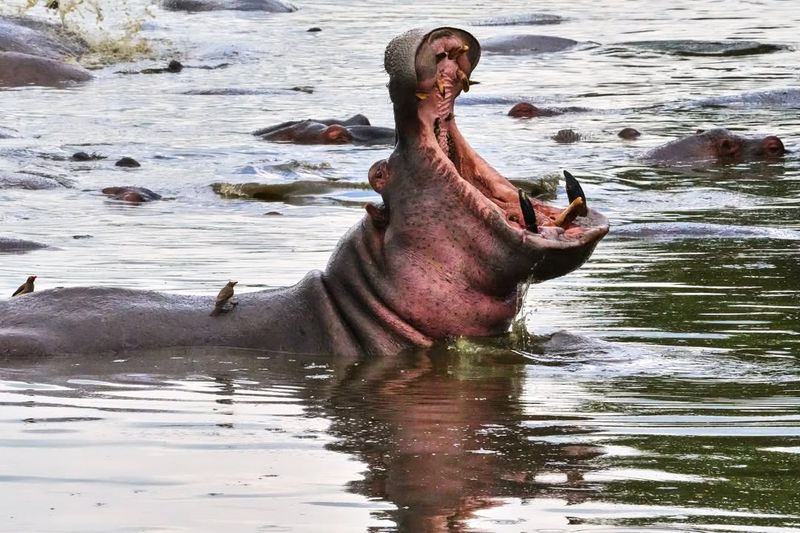
The distinctive physical features of hippos are key to their survival in aquatic environments. Their eyes, ears, and nostrils are positioned on top of their heads, allowing them to see, hear, and breathe while mostly submerged. This adaptation is crucial for maintaining awareness of their surroundings without exposing most of their body.
Their skin, which secretes a natural sunscreen, provides protection from the sun and prevents dehydration. Another unique feature is their ability to close their nostrils and ears underwater, preventing water from entering. These adaptations reflect the evolutionary pressures hippos have faced and their ability to thrive in challenging environments.
Their physiology is a testament to nature’s ingenuity, offering solutions to the demands of their habitat. Understanding these adaptations provides insight into how hippos have successfully occupied their ecological niche. Their physical characteristics underscore the interplay between form and function, highlighting the complexity of their evolutionary journey.
14. Hippos’ Nighttime Grazing Adventure
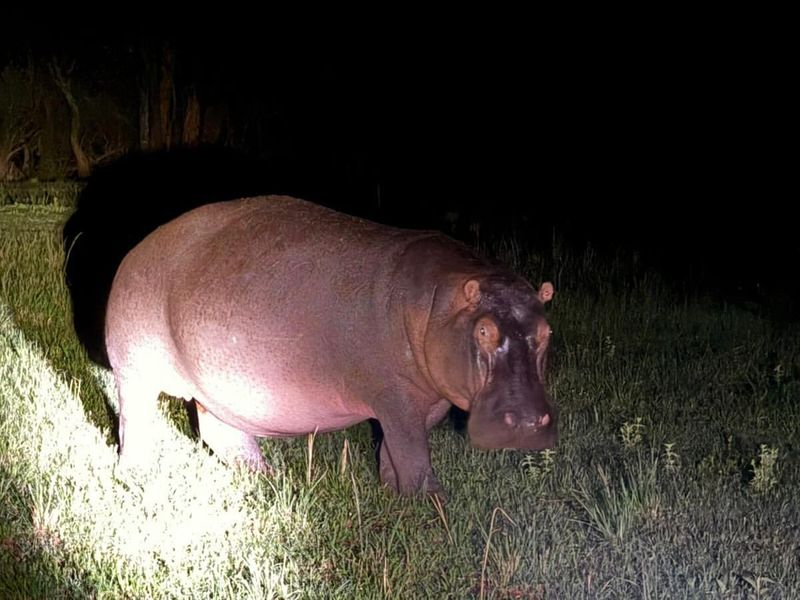
As the sun sets, hippos begin their nightly quest for food, venturing out of water to graze on grass. This nocturnal behavior is driven by the need to avoid the heat of the day, conserving energy and preventing dehydration.
Hippos travel several miles across land during these nighttime expeditions, showcasing their adaptability and resourcefulness. Their grazing helps maintain the balance of their ecosystems by controlling vegetation growth along riverbanks. This feeding pattern also minimizes competition for resources, as few other large herbivores are active at night.
The cover of darkness provides safety from predators, allowing hippos to feed without disturbance. This routine is a crucial aspect of their survival strategy, reflecting the interplay between their dietary needs and environmental conditions.
Observing hippos’ nighttime activities offers a glimpse into their world, highlighting their resilience and the intricacies of their ecological role. This behavior underscores their ability to adapt to the challenges of their habitat, ensuring their continued success.
15. The Misleading Hippo Yawn
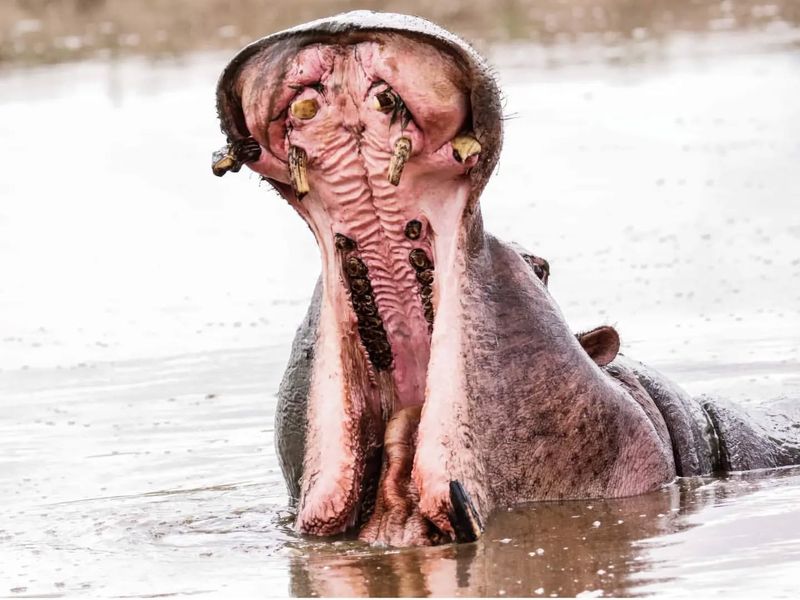
A wide-open mouth in the hippo world is not always a sign of relaxation or fatigue. Instead, this gesture is often a display of dominance or a warning to others. The “yawn” reveals their impressive tusks and teeth, signaling their readiness to defend themselves. In the wild, this behavior is an important part of social interactions, used to establish hierarchy within pods.
The sight of a yawning hippo can be intimidating, serving as a reminder of the power these creatures wield. This behavior is not limited to adults; even young hippos engage in yawning displays to practice assertiveness and understand social dynamics. Observing this interaction provides insight into their social structure and the importance of communication in maintaining order.
The yawn, as a multifaceted behavior, highlights the complexity of hippo interactions and the nuances of their social lives. This seemingly simple action is a key element of their survival strategy, reflecting their intelligence and social awareness.
16. Hippos’ Adaptation To Climate
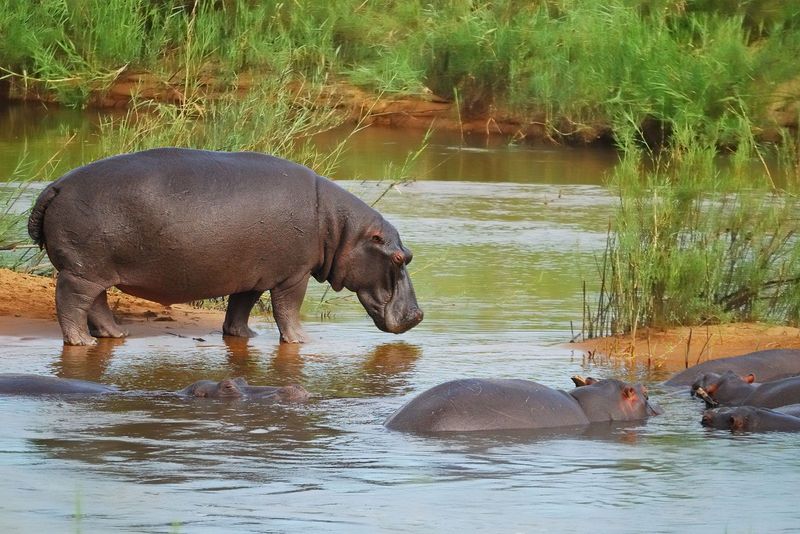
Hippos have evolved to thrive in the warm climates of sub-Saharan Africa, where water is a precious resource. Their adaptation to these environments is evident in their semi-aquatic lifestyle, which helps them stay cool and hydrated.
During dry seasons, hippos rely on water bodies to maintain their body temperature and protect their sensitive skin from sun damage. Their ability to secrete a natural sunscreen further aids in their survival, preventing dehydration and sunburn. This adaptation is crucial in their ability to navigate the challenges posed by fluctuating water levels and climatic conditions.
As environmental changes occur, hippos demonstrate remarkable resilience, adjusting their behavior and habitat use accordingly. This adaptability highlights their capacity to endure and succeed in diverse environmental conditions. Their survival strategies reflect the dynamic relationship between organisms and their environments, emphasizing the need for conservation efforts.
17. Hippo Conservation Efforts
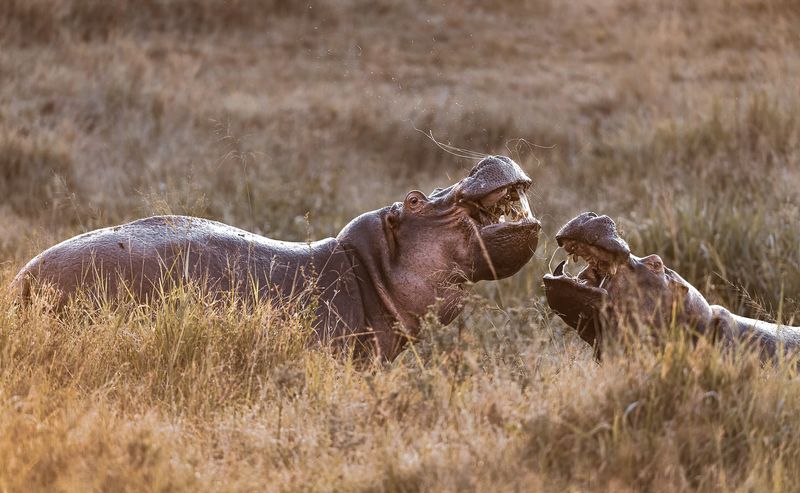
Conservation efforts for hippos are vital to ensuring their survival amid environmental and human-induced challenges. As human activities encroach on their habitats, hippos face threats from habitat loss, conflict with humans, and illegal hunting. Conservation organizations work tirelessly to protect these magnificent creatures by establishing protected areas and promoting sustainable coexistence. These initiatives involve engaging local communities, raising awareness, and implementing strategies that address the root causes of conflict.
By fostering a sense of stewardship, conservationists aim to create a future where hippos can thrive alongside human populations. Education plays a crucial role in these efforts, helping people understand the ecological importance of hippos and the consequences of their decline. Collaborative approaches between governments, NGOs, and local communities are essential in creating effective conservation strategies.
The success of these initiatives hinges on sustainable practices that prioritize the wellbeing of both hippos and the ecosystems they inhabit. Supporting hippo conservation is not only about protecting a species but preserving the intricate balance of their natural habitats.

